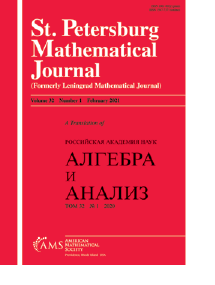Method for computing waveguide scattering matrices in the vicinity of thresholds
HTML articles powered by AMS MathViewer
- by
B. A. Plamenevskiǐ, A. S. Poretskiǐ and O. V. Sarafanov
Translated by: B. A. Plamenevskiǐ - St. Petersburg Math. J. 26 (2015), 91-116
- DOI: https://doi.org/10.1090/S1061-0022-2014-01332-5
- Published electronically: November 21, 2014
- PDF | Request permission
Abstract:
A waveguide occupies a domain $G$ in $\mathbb R^{n+1}$, $n\geq 1$, having several cylindrical outlets to infinity. The waveguide is described by the Dirichlet problem for the Helmholtz equation. The scattering matrix $S(\mu )$ with spectral parameter $\mu$ changes its size when $\mu$ crosses a threshold. To calculate $S(\mu )$ in a neighborhood of a threshold, an “augmented” scattering matrix $\mathcal {S} (\mu )$ is introduced, which keeps its size near the threshold and is analytic in $\mu$ there. A minimizer of a quadratic functional $J^R( \cdot , \mu )$ serves as an approximation to a row of the matrix $\mathcal {S}(\mu )$. To construct such a functional, an auxiliary boundary-value problem is solved in the bounded domain obtained by cutting off the waveguide outlets to infinity at a distance $R$. As $R\to \infty$, the minimizer $a (R, \mu )$ tends exponentially to the corresponding row of $\mathcal {S}(\mu )$ uniformly with respect to $\mu$ in a neighborhood of the threshold. The neighborhood may contain some waveguide eigenvalues corresponding to eigenfunctions exponentially decaying at infinity. Finally, the elements of the “ordinary” scattering matrix $S(\mu )$ are expressed in terms of those of the augmented matrix $\mathcal {S}(\mu )$.
If an interval $[\mu _1, \mu _2]$ of the continuous spectrum contains no thresholds, the corresponding functional $J^R( \cdot , \mu )$ should be defined for the usual matrix $S(\mu )$ and, as $R\to \infty$, its minimizer $a (R, \mu )$ tends to the row of the scattering matrix at exponential rate uniformly with respect to $\mu \in [\mu _1, \mu _2]$.
References
- Sergey A. Nazarov and Boris A. Plamenevsky, Elliptic problems in domains with piecewise smooth boundaries, De Gruyter Expositions in Mathematics, vol. 13, Walter de Gruyter & Co., Berlin, 1994. MR 1283387, DOI 10.1515/9783110848915.525
- B. A. Plamenevskiĭ and O. V. Sarafanov, On a method for computing the scattering matrices of waveguides, Algebra i Analiz 23 (2011), no. 1, 200–231 (Russian, with Russian summary); English transl., St. Petersburg Math. J. 23 (2012), no. 1, 139–160. MR 2760152, DOI 10.1090/S1061-0022-2011-01190-2
- B. A. Plamenevskiĭ and O. V. Sarafanov, On a method for computing waveguide scattering matrices in the presence of the point spectrum, Funktsional. Anal. i Prilozhen. 48 (2014), no. 1, 61–72 (Russian, with Russian summary); English transl., Funct. Anal. Appl. 48 (2014), no. 1, 49–58. MR 3204678, DOI 10.1007/s10688-014-0045-0
- Martin Costabel and Monique Dauge, Stable asymptotics for elliptic systems on plane domains with corners, Comm. Partial Differential Equations 19 (1994), no. 9-10, 1677–1726. MR 1294475, DOI 10.1080/03605309408821068
- Vladimir Maz′ya and Jürgen Rossmann, On a problem of Babuška (stable asymptotics of the solution to the Dirichlet problem for elliptic equations of second order in domains with angular points), Math. Nachr. 155 (1992), 199–220. MR 1231265, DOI 10.1002/mana.19921550115
- I. V. Kamotskiĭ and S. A. Nazarov, Wood’s anomalies and surface waves in the problem of scattering by a periodic boundary. I–II, Mat. Sb. 190 (1999), no. 1, 109–138; no. 2, 43–47; English transl., Sb. Math. 190 (1999), no. 1, 111–141; no. 2, 205–231. MR 11700697 (2000j:35047); MR 1701000 (2000j:35048)
- S. A. Nazarov and B. A. Plamenevskiĭ, Selfadjoint elliptic problems with radiation conditions on the edges of the boundary, Algebra i Analiz 4 (1992), no. 3, 196–225 (Russian, with Russian summary); English transl., St. Petersburg Math. J. 4 (1993), no. 3, 569–594. MR 1190778
- I. V. Kamotskiĭ and S. A. Nazarov, An augmented scattering matrix and exponentially decreasing solutions of an elliptic problem in a cylindrical domain, Zap. Nauchn. Sem. S.-Peterburg. Otdel. Mat. Inst. Steklov. (POMI) 264 (2000), no. Mat. Vopr. Teor. Rasprostr. Voln. 29, 66–82, 322–323 (Russian, with English and Russian summaries); English transl., J. Math. Sci. (New York) 111 (2002), no. 4, 3657–3666. MR 1796996, DOI 10.1023/A:1016377707919
- Israel Gohberg, Seymour Goldberg, and Marinus A. Kaashoek, Classes of linear operators. Vol. I, Operator Theory: Advances and Applications, vol. 49, Birkhäuser Verlag, Basel, 1990. MR 1130394, DOI 10.1007/978-3-0348-7509-7
- I. C. Gohberg and E. I. Sigal, An operator generalization of the logarithmic residue theorem and Rouché’s theorem, Mat. Sb. (N.S.) 84(126) (1971), 607–629 (Russian). MR 0313856
Bibliographic Information
- B. A. Plamenevskiǐ
- Affiliation: Division of Mathematical Physics, Physics Department, St. Petersburg State University, Russia
- Email: boris.plamen@gmail.com
- A. S. Poretskiǐ
- Affiliation: Division of Mathematical Physics, Physics Department, St. Petersburg State University, Russia
- Email: poras1990@list.ru
- O. V. Sarafanov
- Affiliation: Division of Mathematical Physics, Physics Department, St. Petersburg State University, Russia; Division of Mathematical Information Technology, University of Jyväskylä, Finland
- Email: saraf@math.nw.ru
- Published electronically: November 21, 2014
- Additional Notes: The authors were supported by RFBR (grant no. 12-01-00247a) and by Scientific Schools (grant no. 357.2012.1)
- © Copyright 2014 American Mathematical Society
- Journal: St. Petersburg Math. J. 26 (2015), 91-116
- MSC (2010): Primary 47A40
- DOI: https://doi.org/10.1090/S1061-0022-2014-01332-5
- MathSciNet review: 3234806


